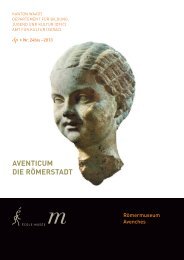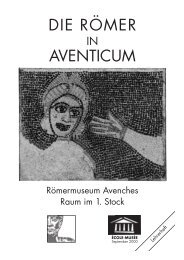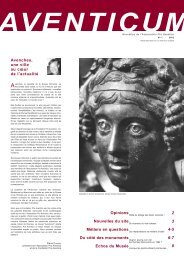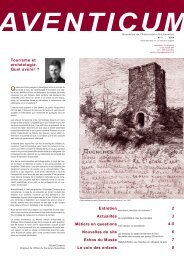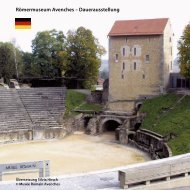Avenches – Roman Museum – Permanent Exhibition
Avenches – Roman Museum – Permanent Exhibition
Avenches – Roman Museum – Permanent Exhibition
You also want an ePaper? Increase the reach of your titles
YUMPU automatically turns print PDFs into web optimized ePapers that Google loves.
Second Floor Furniture<br />
Lighting (1)<br />
(Display case 6)<br />
A Gallo-<strong>Roman</strong> house was naturally lit through its doors and only a few windows,<br />
which were closed at night with wooden shutters. Glass windowpanes were only<br />
found in rich private houses and in the public baths. These windowpanes (nos. 3-5)<br />
with side lengths of 20 to 40 cm were fitted into the openings either in wooden<br />
frames or directly with mortar.<br />
For artificial lighting they used lamps made of pottery, bronze or iron with oil or<br />
tallow being used as a burning agent.<br />
Pottery lamps of Mediterranean origin (nos. 13-20) were often decorated and<br />
bore the maker’s stamp (no. 18). The wick was inserted through a closed nozzle<br />
into the oil chamber, where it was soaked in poor quality olive oil. Some metal<br />
lamps had fittings for suspension so that they could be hung from the ceiling or a<br />
candelabrum. Local types of lamps (nos. 8-12, 24) included open bowls with a wick<br />
swimming in tallow protruding from a lip. Candles, placed in ceramic or, sometimes,<br />
metal candlesticks (nos. 9 and 11), were also used to light the interior of the house.<br />
Those who dared to leave the house at night used torches or lanterns.<br />
Drawing of a lantern and a candelabrum<br />
(Not true to scale)<br />
1-2. Legs of a bronze lantern.<br />
3-5. Windowpane fragments.<br />
6-7. Shaft and foot of bronze candelabrum.<br />
8. Iron tallow lamp.<br />
9-12. Ceramic tallow lamps.<br />
13-20. Ceramic oil lamps (2).<br />
21. Arm of bronze lamp in the shape of a panther.<br />
22-23. Bronze oil lamps.<br />
24. Bronze tallow lamp.<br />
25. Bronze candleholder (?) in the shape of a peacock.<br />
Furniture (p. 52, 1)<br />
(Display case 7)<br />
<strong>Roman</strong> furniture included seats, tables, beds, chests and cupboards mainly made of<br />
wood or wickerwork. Practically nothing has survived, with the exception of metal<br />
fittings such as hinges (nos. 25-27), locks (nos. 13 and 14, 19, 36 and 38) or decorative<br />
elements (nos. 1- 6, 15), sometimes made of bone (nos. 29 <strong>–</strong> 32), ivory (nos. 39-42)<br />
or glass (no. 28). Some pieces of furniture could be directly built into the walls<br />
(benches, dining room couches or shelves).<br />
2<br />
1<br />
51<br />
Second Floor<br />
6<br />
7



